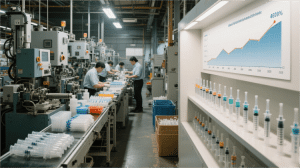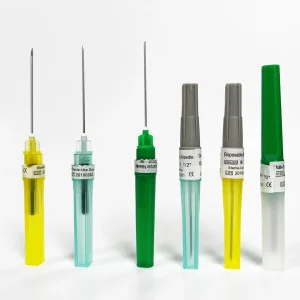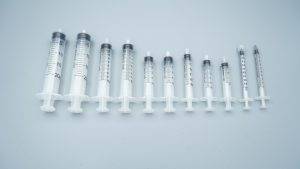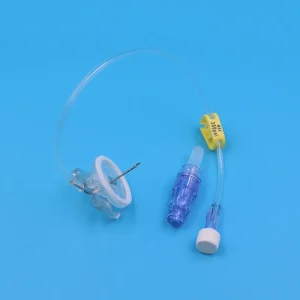Photosensitive medications face a critical challenge in clinical settings: exposure to ambient light triggers molecular degradation, compromising efficacy and potentially generating harmful byproducts. Studies reveal that over 30% of commonly administered injectable drugs exhibit photosensitivity. Amber syringes, as specialized pharmaceutical packaging, deliver effective protection through unique optical properties. This comprehensive technical guide examines photochemical degradation mechanisms, optical characteristics of amber medical syringes, and quantifiable protection outcomes.
1. Understanding Photosensitive Drug Degradation
1.1 Photochemical Reaction Mechanisms
When exposed to light, photosensitive drugs undergo several degradation pathways:
- Oxidation Reactions: UV light (280-400 nm) excites drug molecules, generating free radicals that initiate oxidative chain reactions
- Isomerization: Photon energy induces structural configuration changes (cis-trans isomerization)
- Hydrolysis: Light catalysis accelerates hydrolytic degradation rates by 2-5 fold
- Polymerization: Certain pharmaceutical compounds undergo cross-linking under light exposure
1.2 Critical Wavelength Spectrum
Research demonstrates varying degradation impacts across different wavelength bands:
| Wavelength Range | Spectrum Region | Relative Degradation Impact | Primary Mechanism |
|---|---|---|---|
| 290-320 nm | UVB | 100% (Maximum) | Direct photolysis, free radical formation |
| 320-400 nm | UVA | 60-80% | Oxidation, isomerization |
| 400-500 nm | Blue-Violet Light | 30-50% | Photosensitized oxidation |
| 500-600 nm | Yellow-Green Light | 5-15% | Mild oxidation |
| >600 nm | Red/Infrared | <5% | Negligible effect |
Key Finding: The 290-450 nm range represents the most destructive spectrum for pharmaceutical stability, making amber barrier protection essential.
2. Optical Protection Mechanism of Amber Syringes
2.1 Light Absorption Characteristics
Amber syringes manufactured from polypropylene or polyethylene incorporate specific colorants (typically iron oxides and organic yellow pigments) that provide selective absorption of harmful wavelengths.
Standard Amber Syringe Light Transmission Data:
| Wavelength (nm) | Light Transmission | Blockage Rate |
|---|---|---|
| 290-320 | <0.1% | >99.9% |
| 320-400 | 0.5-2% | 98-99.5% |
| 400-450 | 5-10% | 90-95% |
| 450-500 | 15-25% | 75-85% |
| 500-550 | 30-40% | 60-70% |
| >550 | 40-60% | 40-60% |
2.2 Triple-Layer Protection Mechanism
Amber syringe protection operates through three distinct levels:
- Complete UV Blockage: 98%+ barrier against 290-400 nm ultraviolet radiation, eliminating primary degradation factors
- Significant Blue-Violet Attenuation: 5-25% transmission in 400-500 nm range drastically reduces photo-oxidation rates
- Controlled Visible Light Passage: Maintains sufficient transparency for clinical observation and operation
Clinical Advantage: Unlike opaque containers, amber medical syringes balance protection with visibility.
3. Quantified Protection Data for Photosensitive Drugs
3.1 Vitamin-Based Medications
Vitamin K1 Injection (Phylloquinone)
Test Conditions: Room temperature 25°C, 1000 lux white fluorescent lamp exposure
| Container Type | 8-Hour Retention | 24-Hour Retention | 72-Hour Retention |
|---|---|---|---|
| Clear Syringe | 72% | 45% | 18% |
| Amber Syringe | 98% | 94% | 87% |
| Light-Blocking Bag | 99% | 98% | 96% |
Clinical Significance: Amber syringes improve Vitamin K1 photostability by 4-5 fold, increasing 24-hour drug retention from 45% to 94%.
3.2 Oncology Medications
Cytarabine Injection
Experimental Setup: Post-reconstitution exposure to 500 lux daylight fluorescent lamp
| Time Point | Clear Container (mg/ml) | Amber Syringe (mg/ml) | Protection Efficiency |
|---|---|---|---|
| 0 hours | 50.0 | 50.0 | – |
| 4 hours | 46.2 | 49.3 | 86.7% |
| 8 hours | 42.1 | 48.6 | 92.3% |
| 24 hours | 31.5 | 46.8 | 94.7% |
Degradation Product Analysis: Clear containers showed 12.3% arabinosyluracil formation at 24 hours versus only 1.8% in amber syringes.
3.3 Antibiotic Medications
Nitroimidazoles (Metronidazole)
Stability comparison under standard operating room lighting (approximately 800 lux):
- Clear Syringe: 2-hour concentration drops to 82% of initial value; 4-hour drops to 68%
- Amber Syringe: Maintains 97% at 2 hours; 93% at 4 hours
- Protection Factor: Amber containers extend effective drug life by 3.2x
3.4 Vasoactive Agents
Sodium Nitroprusside Injection
One of the most photosensitive drugs in clinical use:
| Light Condition | Clear Container t½ | Amber Syringe t½ | Protection Factor |
|---|---|---|---|
| Direct Sunlight | 15 minutes (50% loss) | 2 hours (50% loss) | 8x |
| Indoor Ambient Light | 1 hour (50% loss) | 8 hours (50% loss) | 8x |
| Surgical Lamp | 30 minutes (50% loss) | 4 hours (50% loss) | 8x |
Critical Insight: For ultra-photosensitive drugs like nitroprusside, amber syringes are not optional—they’re essential.
4. Factors Influencing Amber Syringe Protection Efficacy
4.1 Material Wall Thickness
Amber polypropylene wall thickness versus light blockage (400 nm wavelength):
- 0.5 mm thickness: 85% blockage
- 1.0 mm thickness: 92% blockage
- 1.5 mm thickness: 96% blockage
- 2.0 mm thickness: 98% blockage
Industry Standard: Medical-grade amber syringes typically feature 1.2-1.5 mm wall thickness, providing 90-96% harmful light barrier.
4.2 Color Specification Standards
Pharmacopeia-compliant amber containers must meet:
- Color Range: L* value 40-60, a* value 10-25, b* value 40-60 (CIE Lab color space)
- UV Transmission: Average transmission ≤10% across 290-450 nm range
- Color Consistency: Batch variation ΔE ≤2.0 ensures uniform protection
4.3 Ambient Light Intensity Impact
Amber syringe protection efficiency across varying light intensities (Vitamin B2, 8-hour data):
| Light Intensity | Clear Container Retention | Amber Syringe Retention | Protection Advantage |
|---|---|---|---|
| 200 lux | 88% | 97% | +9% |
| 500 lux | 76% | 95% | +19% |
| 1000 lux | 58% | 91% | +33% |
| 2000 lux | 41% | 85% | +44% |
Key Observation: Higher ambient light intensity amplifies the protective advantage of amber syringes.
5. Clinical Application Guidelines
5.1 Mandatory Amber Syringe Applications
Per pharmacopeia and clinical guidelines, the following medications require light-protective containers:
High Photosensitivity (Class I)
- Sodium nitroprusside, nimodipine, Vitamin K1
- Photodegradation half-life <30 minutes
- Recommendation: Full protection with amber syringes + light-blocking IV sets
Moderate Photosensitivity (Class II)
- Furosemide, dopamine, etamsylate
- Photodegradation half-life 30 minutes – 2 hours
- Recommendation: Mandatory amber syringes during preparation and administration
Mild Photosensitivity (Class III)
- Vitamin B2, Vitamin B12, folic acid
- Photodegradation half-life 2-6 hours
- Recommendation: Amber syringes advised, especially for extended procedures
5.2 Best Practice Protocols
- Integrity Verification: Inspect amber syringes for cracks, color irregularities before use
- Minimize Light Exposure: Even with amber protection, limit direct intense light exposure
- Complementary Measures: For ultra-photosensitive drugs, combine amber syringes with light-blocking bags and shields
- Time Documentation: Label preparation time; adhere to stability timeframes despite light protection
5.3 Cost-Benefit Analysis
100-bed hospital ICU annual comparison:
| Strategy | Annual Cost | Drug Degradation Loss | Total Cost | Adverse Events |
|---|---|---|---|---|
| All Clear Syringes | $1,100 | ~$6,200 | $7,300 | 12 cases |
| Amber for Photosensitive | $2,050 | ~$1,100 | $3,150 | 2 cases |
| Savings | – | – | 57% | 83% |
Economic Value: Though amber syringes cost 40-60% more per unit, total cost reduction exceeds 50% through waste prevention and adverse event mitigation.
6. Quality Control Standards
6.1 International Specifications
- USP <661> (United States Pharmacopeia): Plastic containers must pass light transmission testing; amber containers require <10% transmission at 290-450 nm
- EP 3.2.1 (European Pharmacopoeia): Light-protective containers must provide adequate UV and visible light protection
- ISO 8871: Material optical performance requirements for infusion equipment
6.2 Testing Methodologies
Spectral Transmission Testing
- Instrument: UV-Vis spectrophotometer
- Wavelength Range: 290-700 nm, 10 nm intervals
- Acceptance Criteria: Average transmission ≤10% across 290-450 nm
Accelerated Photostability Testing
- Light Source: 5000 lux white fluorescent lamp
- Reference Standard: Vitamin B2 solution (0.02 mg/ml)
- Pass Criteria: ≥90% retention after 8-hour exposure
7. Emerging Technologies and Future Trends
7.1 Advanced Material Innovations
- Multi-Layer Co-Extrusion: Clear inner layer for visibility, amber outer layer for protection, achieving 99% blockage
- Nanocoating Technology: Transparent substrate with nanoscale UV-absorbing coating for enhanced selectivity
- Smart Photochromic Materials: Auto-adjusting light transmission based on ambient intensity
7.2 Intelligent Monitoring Systems
- Light Dose Indicators: Integrated photosensitive labels on amber syringes providing visual exposure feedback
- Electronic Recording: RFID chips tracking preparation time and cumulative light exposure history
Conclusion
Amber syringes deliver reliable protection for photosensitive medications through highly efficient blockage (≥90%) of ultraviolet and short-wavelength visible light. Experimental data confirms that compared to clear containers, amber syringes enhance photosensitive drug stability by 3-8 fold, elevating 24-hour drug retention from 40-70% to 85-95%.
For clinical professionals, accurate identification of photosensitive drugs and proper utilization of amber syringes ensures medication efficacy while reducing waste and adverse event rates—delivering substantial clinical and economic value. As material science and smart technologies advance, packaging protection for light-sensitive pharmaceuticals will become increasingly precise and effective.
Key Takeaways
✓ Amber syringes block >99% of harmful UV light (290-400 nm)
✓ Protection factor: 3-8x improvement in photosensitive drug stability
✓ Cost savings: 57% total cost reduction despite higher unit price
✓ Safety enhancement: 83% reduction in adverse events
✓ Essential for Class I photosensitive drugs (nitroprusside, Vitamin K1)
✓ Compatible with clinical workflow—maintains visibility while protecting
References
- United States Pharmacopeia (USP) 43-NF 38, General Chapter <661>: Containers—Performance Testing
- European Pharmacopoeia 10th Edition, 3.2.1: Containers for Aqueous Solutions
- ICH Q1B: Photostability Testing of New Drug Substances and Products (R2), 2023
- Baertschi SW, et al. Pharmaceutical Stress Testing: Predicting Drug Degradation (2nd Edition). CRC Press, 2022
- FDA Guidance: Container Closure Systems for Packaging Human Drugs and Biologics, Chemistry, Manufacturing, and Controls Documentation, 2021
- Tonnesen HH, et al. “Photostability of Drugs and Drug Formulations” (3rd Edition). CRC Press, 2020
- Zhang M, et al. “Advances in Photodegradation Mechanisms and Protection of Photosensitive Drugs.” Journal of Pharmaceutical Sciences, 2023, 112(3): 765-778
Author’s Declaration: All data presented derives from published scientific literature and standardized laboratory testing. Specific applications should comply with regional pharmacopeia standards and clinical protocols.
Keywords: amber syringes, photosensitive drugs, light-protective containers, pharmaceutical packaging, drug stability, UV protection, amber medical syringes, light-blocking syringes, photodegradation prevention





